
Roswell Winans was a highly decorated United States Marine, who as a First Sergeant earned the Medal of Honor during combat in the Dominican Republic. He was later commissioned and served as a company officer with the 5th Marine Regiment in France receiving several citations for bravery in combat.

John Herbert "Babe" Brown, Jr. was a decorated officer in the United States Navy with the rank of Vice admiral during World War II and an American football player. A graduate of the United States Naval Academy, Brown trained as submariner and served successively as Commander, Submarine Squadron 4 and Commander Training Command, Submarine Force, Pacific Fleet in the opening years of World War II. Brown was then promoted to Rear admiral and commanded Cruiser Division One during the bombardment of Japan in summer 1945.

John Walter Wilcox Jr. was a rear admiral of the United States Navy. He saw service in World War I and in the opening weeks of United States involvement in World War II before being lost overboard from his flagship in the North Atlantic Ocean in 1942.
Andrew Boggs Drum was an officer in the United States Marine Corps. He was born in Winchester, Virginia, and moved to Washington, D.C., when he was nine. His father, Andrew B. Drum, Sr., was superintendent of Arlington National Cemetery from 1892 to 1906. He graduated from Western High School in Washington D.C. in 1903 and was commissioned a second lieutenant in the Marine Corps in 1905. Prior to joining the Marines, he had served in the National Guard of the District of Columbia.
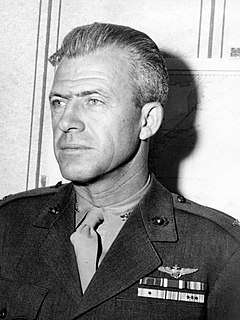
Caleb Thayer "Zeke" Bailey was a decorated officer and naval aviator in the United States Marine Corps with the rank of brigadier general. An excellent athlete while at the University of Maryland, he distinguished himself as center in the UM Terrapins football team and following his commissioning in the Marine, he also excelled in Quantico Marines Devil Dogs football.
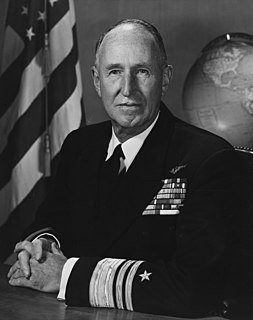
Stuart Howe Ingersoll was a vice admiral of the United States Navy. He was a naval aviator whose career included service as an aircraft carrier commander during World War II and tours as commander-in-chief of the United States Seventh Fleet, President of the Naval War College, and Commandant of Midshipmen at the United States Naval Academy.

Harry Bean Jarrett was a highly decorated officer in the United States Navy with the rank of Vice Admiral. A veteran of several campaigns in Pacific during World War II, he distinguished himself during the Battle of the Coral Sea in May 1942, while commanding destroyer Morris and received the Navy Cross, the second highest decoration of the United States military.

Henry David Cooke Jr. was a highly decorated officer in the United States Navy with the rank of Rear admiral. A graduate of the United States Naval Academy and veteran of several conflicts, he was wounded during the Philippine–American War and later distinguished himself as Commanding officer of destroyer USS Allen during World War I for which received the Navy Cross, the second highest decoration of the United States military awarded for valor.
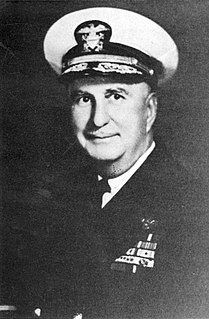
Charles Perry Mason was a highly decorated officer in the United States Navy with the rank of Vice admiral. An early naval aviator, he distinguished himself as Commanding officer of aircraft carrier USS Hornet (CV-8), which was sunk during the Battle of the Santa Cruz Islands in late October 1942. Mason was subsequently promoted to Rear admiral and served successively as Commander, Aircraft, Solomons and Chief of the Naval Air Intermediate Training Command at Naval Air Station Pensacola, Florida.

Roy Moyer Gullick was a decorated officer of the United States Marine Corps with the rank of major general. He spent his senior career mostly in Quartermaster Department, reaching the capacity of Quartermaster General of the Marine Corps. He held this office between dates July 1, 1958 – January 1, 1960.

Francis Stuart Low was a decorated officer of the United States Navy with the rank of four-star Admiral. An expert in submarine warfare, Low is credited with the idea that twin-engined Army bombers could be launched from an aircraft carrier. This idea was later adopted for the planning of the Doolittle Raid.

Frank Dechant Wagner was a highly decorated Naval aviator in the United States Navy with the rank of Vice Admiral. A Naval Academy graduate, Wagner distinguished himself as Commander of Patrol Wing Ten during operations against the enemy in the early weeks of the Japanese Invasion of the Philippines. He was then promoted to the general officer's rank and served as Commander, Aircraft, Seventh Fleet during liberation of the Philippines in 1944–1945.

John Franklin Shafroth Jr. was a highly decorated officer in the United States Navy with the rank of Vice Admiral. He distinguished himself as Commander of destroyer USS Terry during World War I and received the Navy Cross, the United States Navy second-highest decoration awarded for valor in combat.

William Ward Smith was a decorated officer in the United States Navy with the rank of Vice Admiral. A graduate of the Naval Academy and participant of several conflicts, he distinguished himself during World War II as Commander, Cruiser Task Force during the Battles of the Coral Sea and Midway in May and June 1942.
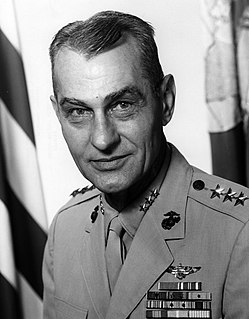
Ralph Kaspar Rottet was a decorated officer and naval aviator in the United States Marine Corps with the rank of lieutenant general. A veteran of World War II, where he distinguished as commanding officer, Marine Aircraft Group 31, he later rose to through the ranks and completed his career as Deputy Chief of Staff for Plans and Programs at Headquarters Marine Corps in 1968.

George Shepard Bowman Jr. was a decorated officer and Naval aviator in the United States Marine Corps. A veteran of three wars, Bowman distinguished himself several times as commander, Marine Aircraft Group 12 in Korea and later rose through the ranks to major general and commander of 2nd Marine Aircraft Wing.
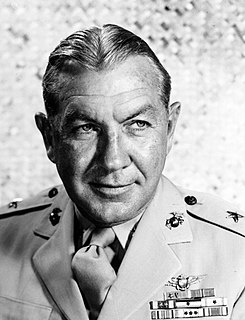
David Ferguson O'Neill was a decorated Naval aviator and officer in the United States Marine Corps with the rank of major general. A veteran of World War II, he commanded Strike Command, Aircraft Solomons on Guadalcanal, New Britain and Bougainville and received several decorations for his service.

Harold Dale Hansen was an officer in the United States Marine Corps with the rank of brigadier general. A veteran of several conflicts, he trained as Quartermaster officer and distinguished himself as Quartermaster of Aircraft, Fleet Marine Force, Pacific during World War II.

Roy Lewis Kline was a decorated naval aviator in the United States Marine Corps with the rank of brigadier general. A veteran of World War II, he distinguished himself as assistant air officer on the staff of Tenth Army during the Battle of Okinawa. Kline later served as Military Secretary to the Commandant of the Marine Corps, General Randolph M. Pate from 1958 to 1960.
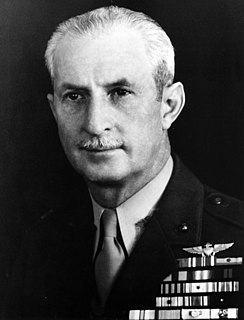
Hayne Davis Boyden was a highly decorated Naval aviator and aviation pioneer in the United States Marine Corps who retired at the rank of Brigadier General. A veteran of several campaigns of the Banana Wars, Boyden became known in the Marine Corps as a pioneer in Aerial photography. He photographed thousands of square miles of Cuba, Haiti, Nicaragua, Panama and the Olympic forestry region of the Pacific northwest. This aerial photography became the basis for mosaic maps of these areas.




















